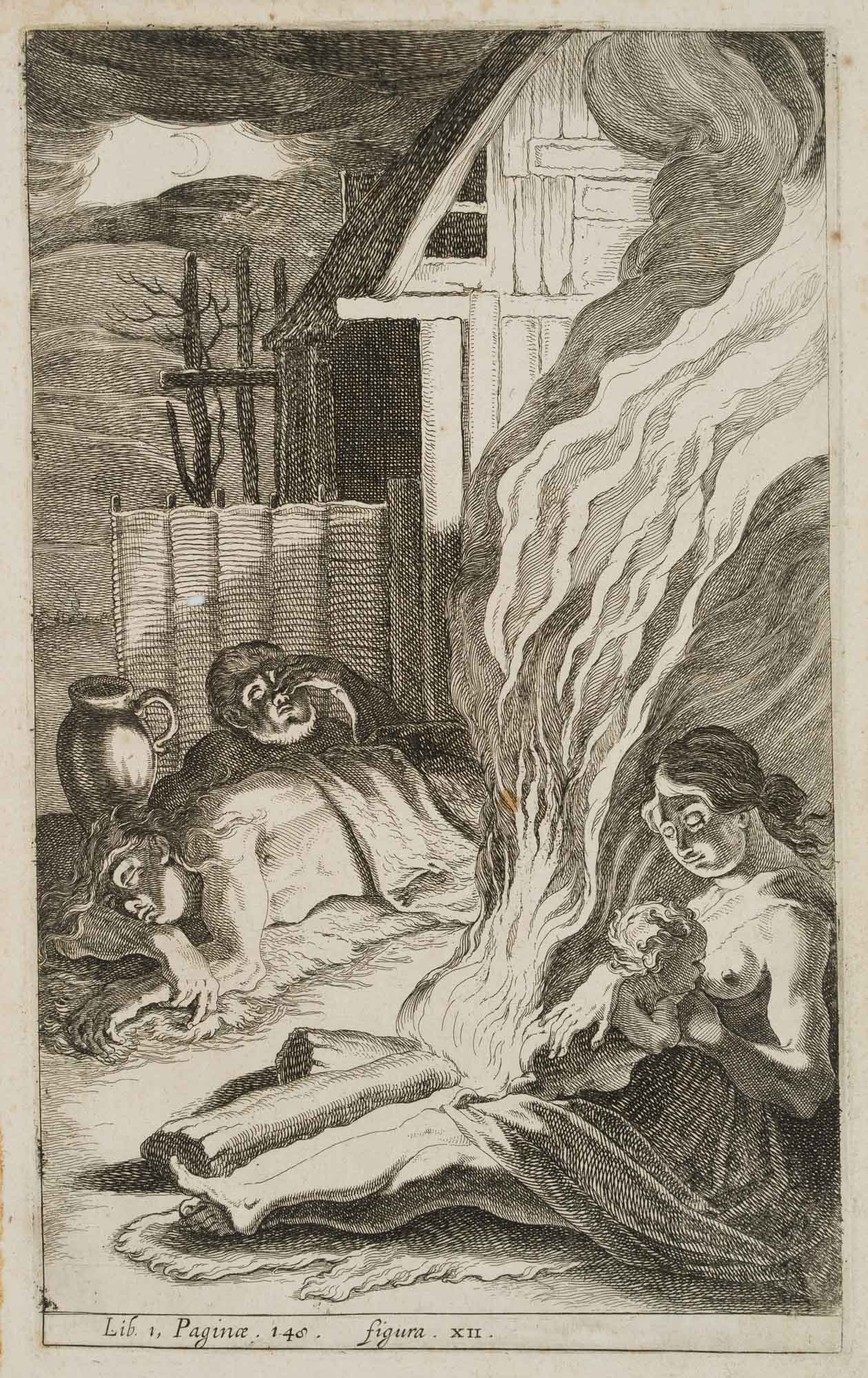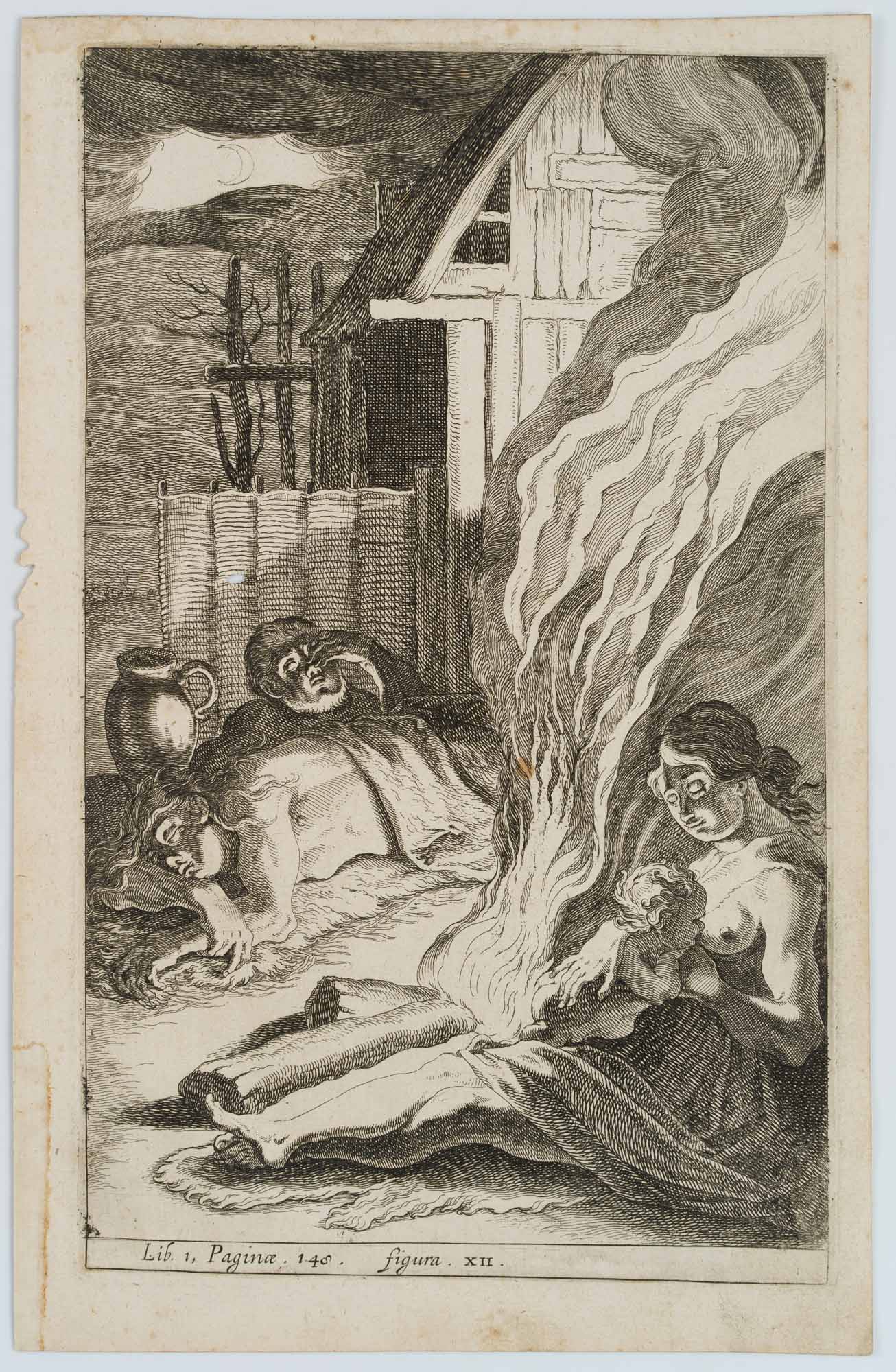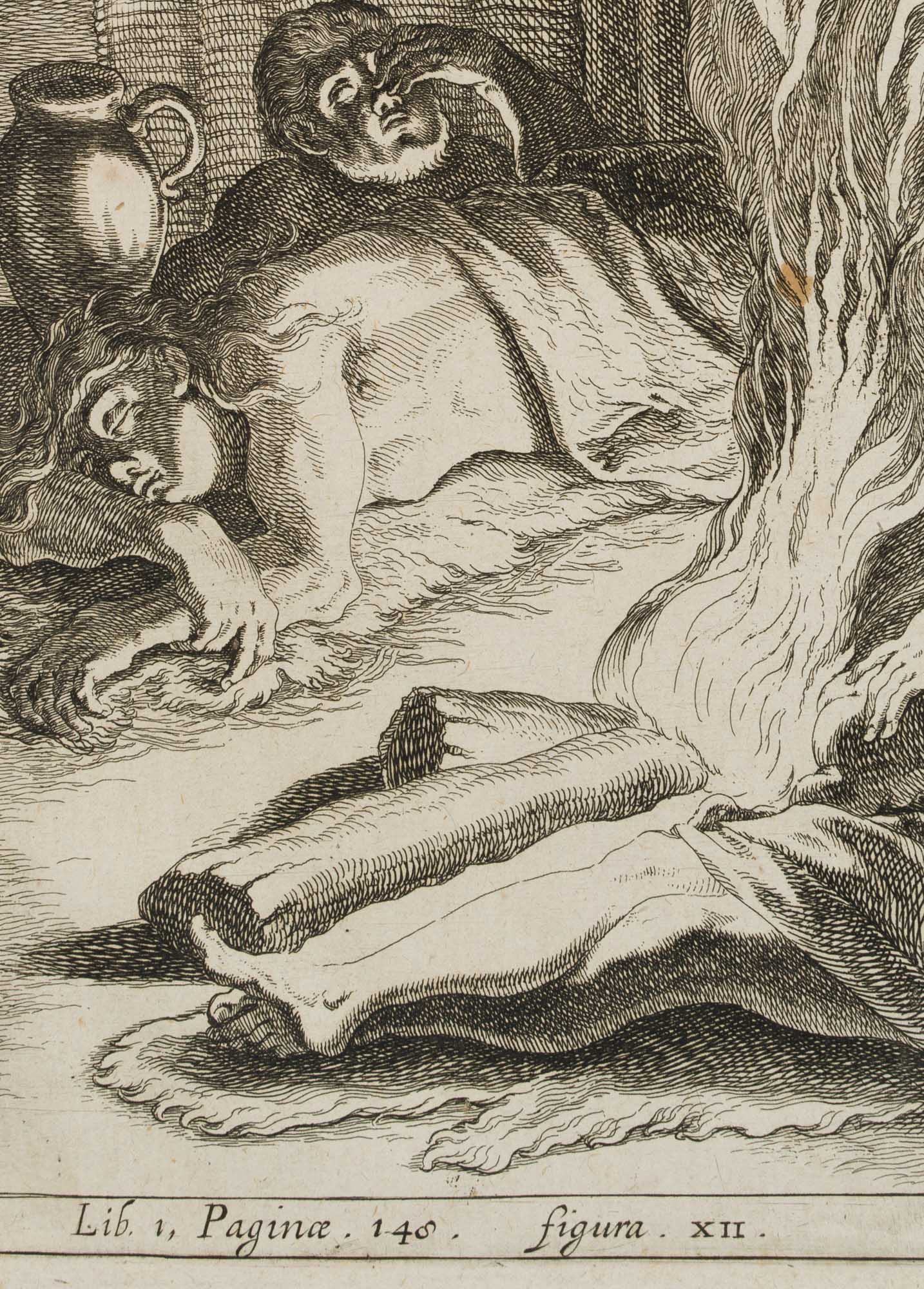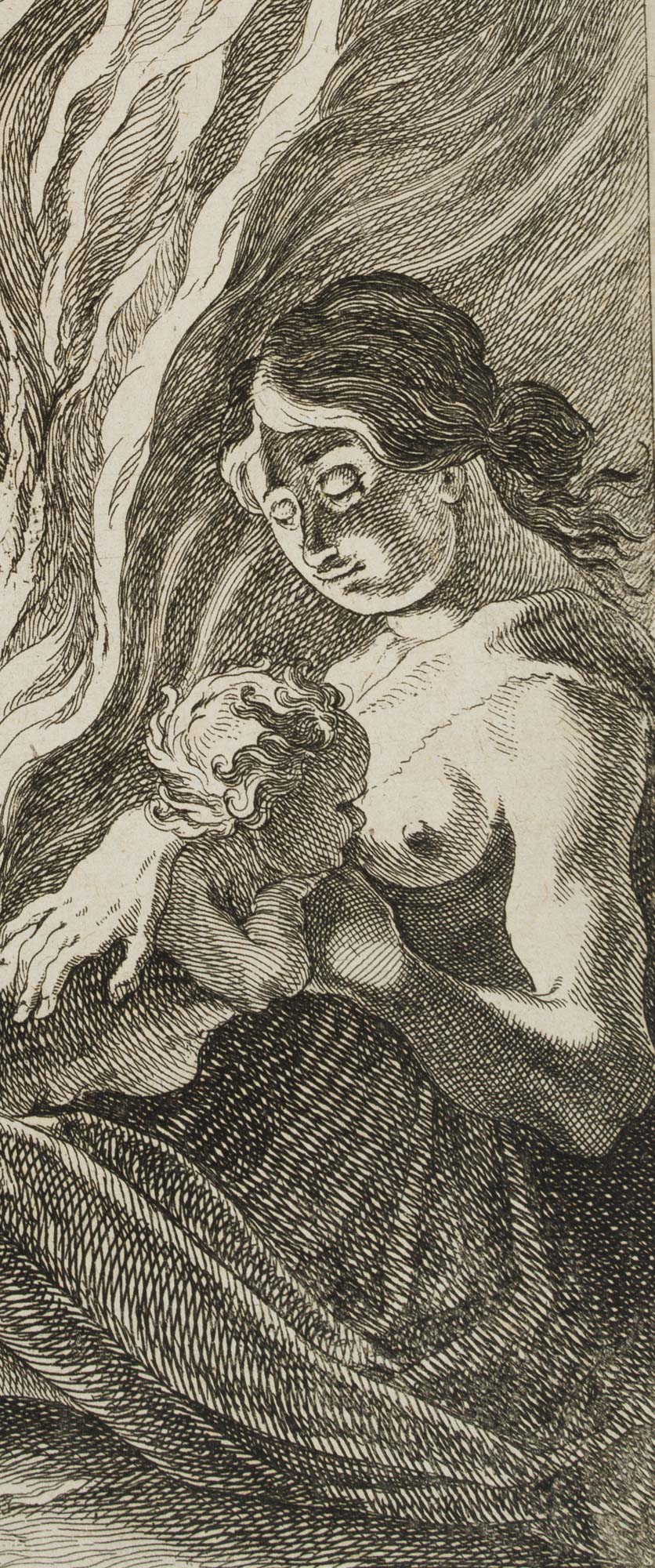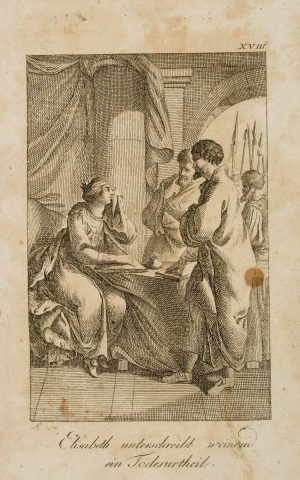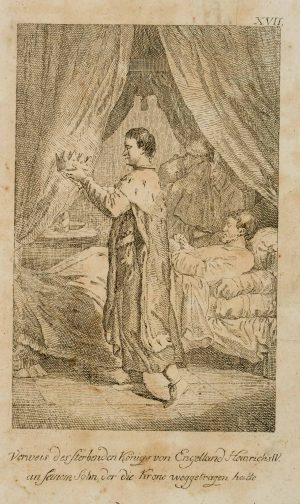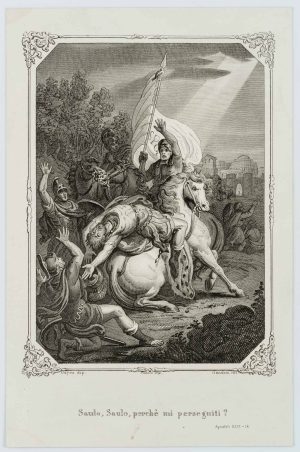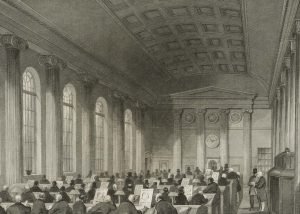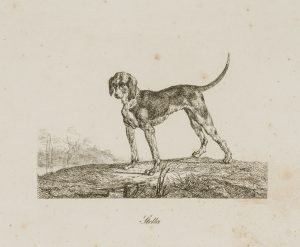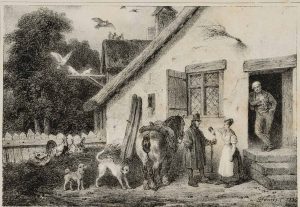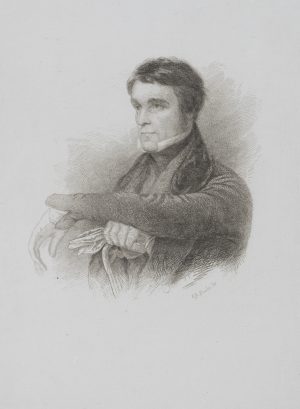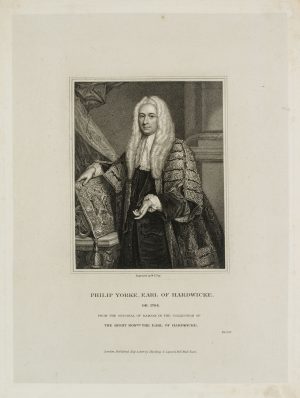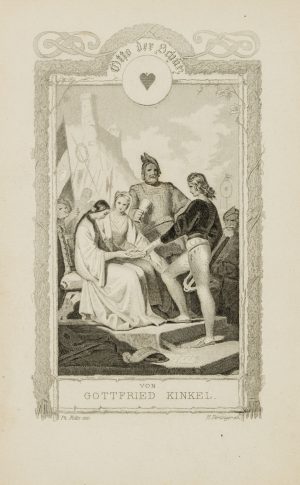Philipp Clüver (1580 Danzig – 1622 Leiden), aus: „Germaniae Antiquae libri tres. Adjectae sunt Vindelicae et Noricum“, Buch 1, Schlafende Germanen und stillende Mutter an der Feuerstelle, um 1616, Radierung
- Technik: Radierung auf Büttenpapier
- Datierung: um 1616
- Beschreibung: Schöner, satter Druck; unter der Darstellung paginiert „Lib. 1, Pagina 146, figura xII“; aus Philipp Clüvers 1616 erschienenem Hauptwerk „Germania antiqua“, mit dem er entscheidend zur Konsolidierung einer über Jahrhunderte nachwirkenden Germanenikonographie beitrug. Seine innovative Leistung bestand darin, eine – aus damaliger Perspektive – historisch möglichst korrekte Darstellungsweise anzustreben – hatten die Illustrationen des 16. Jahrhunderts die germanischen Protagonisten doch noch in zeitgenössischer Mode oder „Fantasiekostümen“ wiedergegeben. Clüvers Darstellungen in der „Germania antiqua“ wurden von Tacitus‘ Äußerungen zur germanischen Kleidung, der etwa die Umhänge aus Tierfell und die sonstige Nacktheit beschreibt, beeinflusst. Die hier gezeigte Radierung stammt aus dem ersten Band, der neben zwei gestochenen Landkarten insgesamt 26 unsignierte Radierungen enthält, welche von Simon Frisius, Nicolaas van Geilenkercken und einer dritten Hand aus dem Umkreis des Verlegers Hendrick Hondius d.Ä. geätzt wurden. Dargestellt sind Szenen aus dem alltäglichen Leben der germanischen Stämme, ihre religiösen Riten und Bräuche sowie gerüstete Krieger, die in den Kampf ziehen. Das in seiner „Germania antiqua“ vermittelte Germanenbild blieb lange Zeit prägend, so lässt sich Clüvers Eindruck in den Bildkünsten bis weit ins 18. Jahrhundert verfolgen, wie etwa anhand der „Hermannschlacht“ Daniel Chodowieckis von 1782. Literatur: Ulrich Pfisterer, Cristina Ruggero (Hg.): Phönix aus der Asche. Bildwerdung der Antike – Druckgrafiken bis 1869, München 2019, S. 33-35.
- Schlagworte: Trachten, Genre, Niederlande, Figürlich, 1600-1649
- Größe: 28,3 cm x 18,1 cm, Darstellung: 26,0 cm x 15,7 cm
- Zustand: Die Darstellung macht einen sehr guten Eindruck. Das Blatt ist altersbedingt gebräunt und stockfleckig; links im Bereich des Zaunes und in der Ecke oben links mit kleinem Loch; am linken Blattrand mit Spuren der Herauslösung aus einer Bindung.
English Version:
Philipp Clüver (1580 Gdansk – 1622 Leiden), from: „Germaniae Antiquae libri tres Adjectae sunt Vindelicae et Noricum“, Book 1, Sleeping Teutons and nursing mother at the hearth, c. 1616, Etching
- Technique: Etching on
- Date: c. 1616
- Description: Nice, rich impression; paginated under the illustration „Lib. 1, Pagina 146, figura xII“; from Philipp Clüver’s main work „Germania antiqua“, published in 1616, with which he decisively contributed to the consolidation of a Germanic iconography that was to have a lasting effect for centuries. His innovative achievement was to strive for a mode of representation that was – from the perspective of the time – as historically correct as possible – after all, the illustrations of the 16th century had still depicted the Germanic protagonists in contemporary fashion or „fantasy costumes“. Clüver’s depictions in the „Germania antiqua“ were influenced by Tacitus‘ remarks on Germanic clothing, describing, for example, cloaks made of animal fur and other nudity. The etching shown here is from the first volume, which, in addition to two engraved maps, contains a total of 26 unsigned etchings etched by Simon Frisius, Nicolaas van Geilenkercken and a third hand from the circle of the publisher Hendrick Hondius the Elder. Depicted are scenes from the everyday life of the Germanic tribes, their religious rites and customs as well as armed warriors going into battle. The image of the Germanic tribes conveyed in his „Germania antiqua“ remained influential for a long time, and Clüver’s impression on the visual arts can be traced well into the 18th century, for example in Daniel Chodowiecki’s „Hermannschlacht“ from 1782. Literature: Ulrich Pfisterer, Cristina Ruggero (eds.): Phönix aus der Asche. Bildwerdung der Antike – Druckgrafiken bis 1869, Munich 2019, pp. 33-35.
- Keywords: 17th century, Figurative, Costumes, Netherlands,
- Size: 28,3 cm x 18,1 cm (11,1 x 7,1 in), Depiction: 26,0 cm x 15,7 cm (10,2 x 6,2 in)
- Condition: The image makes a very good impression. The sheet is browned and foxed due to its age; on the left in the area of the fence and in the upper left corner with a small hole; on the left margin with traces of detachment from a binding.

